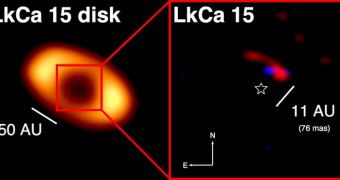A group of astronomers from the University of Hawaii and the Australian Astronomical Observatory (AAO) announce the discovery of what may very well be the youngest extrasolar planet ever found.
The object is believed to be forming even at this point. Preliminary analyses indicate that the entire stellar system - which is centered around the star LkCa 15 – is no more than 2 million years old.
Scientists believe that such investigations have the ability to significantly improve our understanding of how exoplanets form. Studies including this one could therefore provide use with more data on how planets in our own solar system developed.
The forming exoplanet has been termed LkCa 15b, since it is the closest object orbiting its parent star. The team says that the object is still consuming gas and dust from the protoplanetary disk in which it develops, Universe Today reports.
According to the UH/AAO team, this is the youngest exoplanet ever imaged directly. Interestingly, the object is orbiting a Sun-sized star. “We really have the age of the star and not the planet,” Michael Ireland explains.
“The age of the star was determined by a great many people studying the gravitational contraction of both LkCa 15 and all of the other stars in the Taurus star forming region, which formed at nearly the same time,” adds the expert, who is an AAO lecturer in astrophotonics.
He explains that his team used the 10-meter Keck Observatory atop Mauna Kea in order to make the discovery. The installation is outfitted with adaptive optics – which allow the team to compensate for interferences from clouds in the atmosphere – and is capable of aperture mask interferometry.
The latter is a technique which enables astronomers to observe the protoplanetary disk around an exoplanet without having the telescope be blinded by the intense brightness of the cosmic fireball.
““It’s like we have an array of small mirrors. We can manipulate the light and cancel out distortions,” explains University of Hawaii Institute for Astronomy expert astronomer Adam Kraus.
“The protoplanet is heated up by its gravitational contraction energy. Gravitational potential energy is enough to make a truck’s brakes really hot when it goes down a mountain too fast,” Ireland says.
“The potential energy of an entire planet being dropped onto itself is enough to make it glow red hot for millions of years. The planet is more than 1000 degrees Celsius – measuring its temperature more accurately is one of our goals next year,” he adds.
“The dust and gas is mostly heated by the radiation field of the star and planet, and in equilibrium, reaches a temperature of less than 100 kelvins [-170 degrees Celsius],” the expert concludes.

 14 DAY TRIAL //
14 DAY TRIAL //